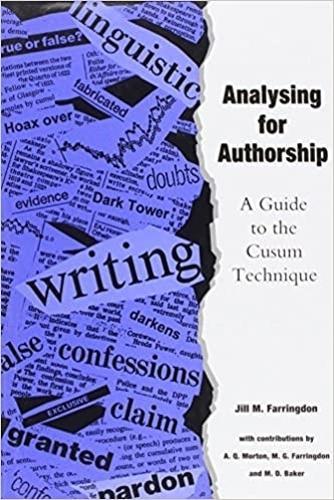Awards
- Winner of Calvin & Rose G Hoffman Memorial Prize for Distinguished Publication on Christopher Marlowe 1997
- Winner of Calvin & Rose G Hoffman Memorial Prize for Distinguished Publication on Christopher Marlowe 1997.
Overview
The need to attribute disputed utterance constantly arises, sometimes as a matter of legal urgency (contested 'confessions' or other documents), sometimes as the focus of fierce scholarly debate (was that new story just discovered really by D.H. Lawrence? QSUM finds not), sometimes as a popular diversion (whose words were on the 'Royal Tapes'?) It is in such situations that a scientific method of attribution - one which is objective - becomes desirable. The cumulative sum technique for authorship attribution (Cusum or QSUM, as the analytic procedure is now known) is just such a method. Invented in 1988 by Andre Q. Morton, long recognised as the foremost authority on the subject, QSUM is fully explained with copious illustrations. The technique works cross time and genre, and has already been used to solve several attribution problems. It has obvious uses in legal work, past and present (did Derek Bentley really make that confession? - again, QSUM finds not).
Full Product Details
Author: Jill M. Farringdon ,
A. Q. Morton ,
Michael G. Farringdon ,
M. D. Baker
Publisher: University of Wales Press
Imprint: University of Wales Press
Dimensions:
Width: 13.80cm
, Height: 2.50cm
, Length: 21.60cm
ISBN: 9780708313244
ISBN 10: 0708313248
Pages: 356
Publication Date: 20 June 1996
Audience:
College/higher education
,
Professional and scholarly
,
Undergraduate
,
Postgraduate, Research & Scholarly
Format: Hardback
Publisher's Status: Active
Availability: Out of stock

The supplier is temporarily out of stock of this item. It will be ordered for you on backorder and shipped when it becomes available.
Reviews
. . . a fascinating book. . .for the first time, the QSUM technique is explained in lucid detail, the objections to it are cogently refuted, and the method''s efficacy in solving particular problems of authorship attribution in literature and in law is, in a quite literal sense, graphically demonstrated. There is a remarkable chapter on the development of speech in Helen Keller. And there are literary examples aplenty, among them the authors of The Federalist papers (James Madison and Alexander Hamilton) and Mark Twain; D. H. Lawrence, Muriel Spark, Tom Stoppard, Anthony Burgess - and Henry Fielding . . . There are pitfalls to be avoided, and technical subtleties to be mastered. . .Jill Farringdon carefully identifies these difficulties and, in prose that is clear and jargon free, tells us how to deal with them. -Professor Martin C. Battestin, Department of English, University of Virginia -- Professor Martin C. Battestin
. . . a fascinating book. . .for the first time, the QSUM technique is explained in lucid detail, the objections to it are cogently refuted, and the method's efficacy in solving particular problems of authorship attribution in literature and in law is, in a quite literal sense, graphically demonstrated. There is a remarkable chapter on the development of speech in Helen Keller. And there are literary examples aplenty, among them the authors of The Federalist papers (James Madison and Alexander Hamilton) and Mark Twain; D. H. Lawrence, Muriel Spark, Tom Stoppard, Anthony Burgess - and Henry Fielding . . . There are pitfalls to be avoided, and technical subtleties to be mastered. . .Jill Farringdon carefully identifies these difficulties and, in prose that is clear and jargon free, tells us how to deal with them. -Professor Martin C. Battestin, Department of English, University of Virginia--Professor Martin C. Battestin
, . . a remarkable book in applied stylometry . . . -The Semiotic Review of Books For those inclined to look into its possibilities there is certainly no other book so well able to introduce, explain and illustrate this method of analysis. -Swansea Review A first-rate book, a definitive and admirably lucid exposition of the QSUM technique. -Sir Kenneth Dover --Sir Kenneth Dover



